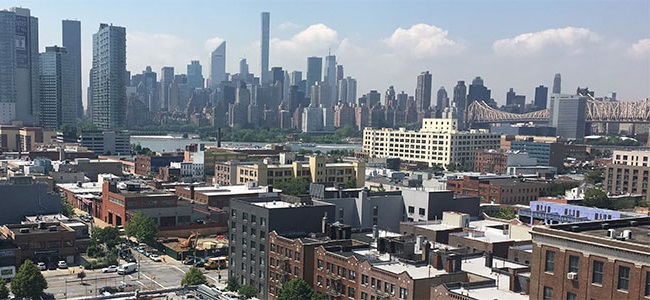
OneLIC Neighborhood Plan will update outdated zoning and expand access to the waterfront. Image Credit: DCP.
April 21, 2025 By Shane O’Brien
The OneLIC Neighborhood Plan officially entered the city’s Uniform Land Use Review Procedure (ULURP) on Monday, following certification by the City Planning Commission.
The sweeping proposal aims to transform a large portion of Long Island City with new zoning rules that would create nearly 14,700 housing units—including 4,300 affordable homes—alongside 14,400 jobs, over 3.5 million square feet of commercial and industrial space, and expanded access to the East River waterfront.
Mayor Eric Adams, alongside Department of City Planning Director and City Planning Commission Chair Dan Garodnick, announced the certification as a milestone in the administration’s housing agenda. OneLIC is the fifth neighborhood plan to begin public review under Adams, who said the project reflects his administration’s commitment to addressing New York City’s housing crisis through large-scale rezoning.
“In order to make New York City the best place to raise a family, we need more affordable homes and more good-paying jobs, and the OneLIC Neighborhood Plan will help create both,” Adams said in a statement.

Via NYC Planning
The OneLIC proposal covers 54 full or partial blocks from Gantry Plaza State Park to the Queensbridge Houses and north to the Long Island City Industrial Business Zone. The eastern boundary extends to Court Square and 23rd Street. The plan aims to revise outdated zoning regulations to allow for more mixed-use development, increase housing supply, and improve neighborhood infrastructure and resiliency.
Council Member Julie Won, who represents the area, helped develop the plan alongside DCP through an 18-month community engagement process. She said the plan was shaped by thousands of public comments and survey responses.
“After 18 months of extensive public engagement, which shaped our community priorities, I am energized to enter certification and negotiations for OneLIC,” Won said. “I will fight to ensure the final OneLIC Neighborhood Plan delivers resiliency, sustainability, and longevity, through commitments on deeply affordable housing, pathways to affordable home ownership, thousands of additional school seats, a connected waterfront, new green spaces, and more.”
The plan would mandate affordable housing under the city’s Mandatory Inclusionary Housing (MIH) program in Long Island City for the first time. Of the 4,300 affordable units proposed, approximately 4,000 would be developed through MIH, with 25 percent of those at 60 percent of Area Median Income (AMI), 30 percent at 80 percent AMI, and 20 percent at 40 percent AMI. The city will also use public sites, such as the Department of Transportation facility at 44-59 45th Ave., to build additional income-restricted housing, including a planned 320-unit project.
Garodnick said the proposal marks the largest number of housing units generated by a neighborhood rezoning in New York City in at least 25 years.
“While parts of the neighborhood have seen remarkable growth in the past two decades, other parts remain frozen in time by outdated zoning,” Garodnick said. “Maintaining the status quo simply doesn’t make sense, especially during a housing crisis that is historic.”

OneLIC Neighborhood Plan would unify the waterfront from Gantry Plaza State Park to
Queensbridge Park, creating a consistent public space for the neighborhood. Image Credit: DCP.
The plan also includes approximately nine acres of new public open space, including expanded parks and plazas, as well as improved streetscapes, sidewalk safety, and pedestrian crossings. It updates the Waterfront Access Plan to unify and enhance public waterfront access from Gantry Plaza State Park to Queensbridge Park.
In addition, the city is pursuing a Request for Information for the six-story, 672,000-square-foot Department of Education building at 44-36 Vernon Blvd. Officials say the publicly-owned sites could support community-focused uses such as housing, commercial space, cultural facilities, and green infrastructure.
The City Planning Commission’s certification begins the seven-month ULURP process. Community Boards 1 and 2 will hold a joint public hearing on the proposal on May 21 at LaGuardia Community College’s Mainstage Theater. The boards must issue advisory recommendations within 60 days, followed by a non-binding recommendation from Queens Borough President Donovan Richards. The CPC will then hold its own hearing and binding vote, before the proposal goes to the City Council for final approval. The mayor can veto the plan within five days of the Council’s vote.

OneLIC Neighborhood Plan would transform Long Island City with thousands of new homes and
jobs, creating a more affordable neighborhood for New Yorkers. Image Credit: DCP.
The OneLIC proposal reflects input from more than 1,600 participants across 15 public meetings, in addition to over 5,700 public comments and 2,350 survey responses, according to city officials. Partners in the planning process included the Queensbridge Houses Tenant Associations, Long Island City Partnership, Queens Community Boards 1 and 2, and the Hunters Point Parks Conservancy.
“With Long Island City at the geographic center of the city, and as a hub where jobs, housing, industry, arts, culture, and community all intersect, we need zoning that reflects our current reality and supports our continued growth,” said Laura Rothrock, president of the Long Island City Partnership.
If adopted, the OneLIC plan will complement ongoing investments in parks, schools, and infrastructure, including projects at Queensbridge Park, Court Square Park, and Murray Playground, as well as new schools such as Q341 and Q508.
The Adams administration projects that its five neighborhood plans—OneLIC, Midtown South, Jamaica, Atlantic Avenue, and the Bronx-Metro North Station Area Plan—will collectively deliver over 50,000 housing units in the next 15 years.
2 Comments

Connecting Gantry to Queensbridge isn’t going to go the way they think. A child would understand this, but Julie Won and the rest aren’t as smart as a child.
LIC is very nice right now. So naturally, these parasites will find a way to ruin it. This is the way.
Thousands of jobs lost, including small maintenance and light manufacturing supports for the entire city. A jaw dropping robbery. Julie Won marched in with a plan, flim-flam-showed it, had pre-prepared City planners holding fully scoped out “visions.” Billions will be thrown at construction, and billions lost, in livelihoods and manufacturing businesses, all in an area without transit access, roads, water and electric grid infrastructures. A jaw-dropping opportunity, such as the Great Leap Forward, or Robert Moses’ plowing through neighborhoods to ruthlessly put his “visions” in place.